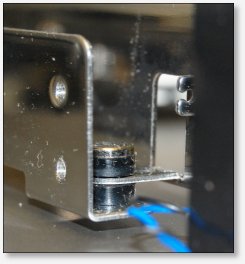 The Eternal Problem of Backups - internal trayless SATA drive bay
The Eternal Problem of Backups - internal trayless SATA drive bay
2010-02-06
Anyone who uses a computer in a creative capacity will no doubt know what I mean when I say that backups are a problem.
Over recent years the sheer volume of data that we keep on our computers has exploded, what with the huge popularity (and megapixel-inflation) of digital cameras, cellphones capable of recording video clips, the accessibility and affordability of digital recorders and music-making software. It all adds up, and finding an affordable and hassle-free media for backing up such a huge amount of data is difficult – consequently, all too often it doesn't get done at all!
The media I've considered using in the past included:
- CD, and later DVD. Very useful for backing up specific projects, but not for data en-masse since the capacity is low. There are also concerns with media life, though I can't say I've personally had any discs go bad.
- Tape. Still very much used in the “real world”, for backing up servers and suchlike, but rather expensive for home or small office use.
- Hard drives. These have good capacity for the price, but there are disadvantages to the main ways they can be connected:
- Internal connection: The obvious flaw here is the need to open the case!
- USB hard drive enclosures. The biggest problem with these is the need for an external power supply - especially since if you have more than one of them from different sources you could well end up with identical looking power connectors that are wired differently! Smaller 2.5inch USB hard drives can solve this problem but they're a bit of a gamble, especially on cheaper desktop computers, where the USB ports can be too weak to provide enough juice. Speed leaves a little to be desired, too.
- E-SATA. A standard for using external hard-drives without the problems inherent in using USB. The computer needs an e-SATA port, however, though these can be added by way of a PCI card.
- Removable hard-drive caddies. These take up a 5.25 inch bay in the computer, and enclose the hard-drive in a removable drawer, which in theory can be interchanged. There are two problems with these – firstly finding an affordable model for which you can obtain extra drawers is tricky, and secondly, the hard-drive is enclosed, which means a fan is needed to keep it cool. There's no room for a decent sized fan, so you get a noisy little one instead.
The design of SATA hard drives opens up a new possibility, however. Because not only are the data and power connectors in a standardized location, but the connectors are now robust edge connectors, not easily-bendable pins, it's now possible to make a trayless removable hard-drive enclosure – and I've just bought one such device, a StarTech HSB100SATBK, to try it out. The total cost was about £16 including postage from Amazon.
As you can see, the tray is completely open top and bottom, so once installed there's plenty of ventilation. Note also, the mountings at the side – the actual body of the drive is “suspended” via some little rubber bushings, from the brackets which screw into the drive bay – so the drive is isolated from vibrations coming through the case. At the front there's hinged door with a release handle, and also a rather optimistic lock that might prevent an intruder from making off with your drive for, oh, maybe 15 seconds or so. There's also a hard-drive activity light - which I ignored, since it would need to be connected to the motherboard to work.
But this thing's designed for convenience, not security – and having opened the door, you simply slide a bare hard drive in, push it home, close the door, and bingo, you have an extra drive attached to your system. Whether or not a hot-plugged drive will be automatically spotted without rebooting depends very much on whether your motherboard/chipset/operating system consider SATA-connected drives as removable. Mine doesn't, so under Linux I can force a bus-rescan with some obscure commands found here: http://www.sakana.fr/blog/2009/05/04/linux-sata-hot-plug-unplug/
I daresay there's equivalent voodoo to achieve the same thing under Windows, too.
When you pull the release lever and open the door, a linkage causes a little bar at the back to push the drive forward far enough for you to get hold of it and pull it out – which brings me to the one downside of this drive enclosure: When inserting or removing a drive, you're handling the drive bare - so there's greater potential for ESD damage to occur than with drives that are enclosed in drawers or caddies.
Provided you take sensible precautions, however, like grounding yourself on the computer case before inserting or removing the drive, and storing it in the original anti-static packaging while not in use, this shouldn't be a huge issue. Even if a drive does fail (which, don't forget, can happen anyway), you're religiously using a 3-generation backup regime with at least one copy off-site to guard against such a failure, right?
Build quality seems pretty good - it's a little lightweight, but then it's an inexpensive device - there are more expensive models available, including one from Antec, which I suspect would be far more solidly built - but also somewhat overspecified for my needs! All in all, I consider this a good buy and shall be picking up another one for myself and one for work in due course.






